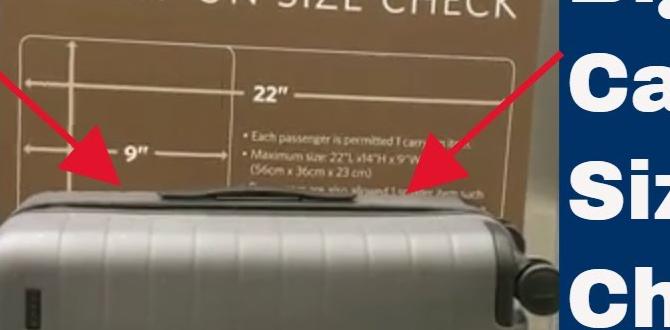Brazil Airport to City Transport: Your Quick Guide
Getting from Brazilian airports to your city destination is straightforward. This guide covers the easiest and most reliable transport options, helping you choose the best fit for your budget and travel style. Get ready for a smooth start to your Brazilian adventure!
Brazil is an incredible country, vibrant and full of life! As you step off the plane at one of its many international airports, the next step is getting to your final destination in the city. It can feel a bit overwhelming at first, especially if you’re new to Brazil. But don’t worry, finding your way is simpler than you might think!
This guide is here to make that journey stress-free. We’ll break down all the options, from quick taxis to budget-friendly buses. You’ll know exactly what to expect and how to make the best choice for you. Let’s get you from the terminal to your next amazing experience, smoothly and confidently!
Choosing Your Brazil Airport to City Transport
When you arrive in Brazil, you’ll find several reliable ways to get from the airport to your hotel or next stop. The best option for you depends on your priorities: speed, cost, convenience, or a combination of these. Let’s explore the most common choices available at major Brazilian airports like São Paulo–Guarulhos (GRU), Rio de Janeiro–Galeão (GIG), and Brasília (BSB).
Understanding your options upfront can save you time and money, not to mention a good dose of stress. Whether you’re traveling solo, with your family, or even managing specific needs like comfort for extended travel, having a plan is key. Think about how much luggage you have, if you need space for a stroller, or extra comfort items for a long journey. This planning ensures a smoother start to your travels.
1. Airport Taxis: Convenience and Directness
Taxis are often the most convenient and direct way to get from Brazilian airports to your city accommodation. They offer door-to-door service, which is especially helpful if you have a lot of luggage or are traveling with children.
When you arrive, you’ll typically find a designated taxi rank outside the arrivals hall. It’s highly recommended to use official airport taxis or reputable ride-hailing services to ensure safety and fair pricing. Avoid unmarked cars or unsolicited offers inside the terminal.
Why Choose Taxis?
- Door-to-door service: No need to navigate multiple modes of transport.
- Speed: Generally the quickest option, especially outside peak traffic hours.
- Comfort: Private and comfortable, ideal for families or those with mobility needs.
- Convenience: Available 24/7 after your flight lands.
Things to Consider with Taxis
- Cost: Taxis are usually more expensive than public transport. Prices can vary significantly based on traffic and distance.
- Traffic: Brazilian cities can have heavy traffic, which will increase your travel time and fare.
- Language: While many drivers speak some English, it’s helpful to have your destination address written in Portuguese.
For a smoother taxi experience, consider pre-booking an airport transfer service. This can sometimes offer fixed rates and ensure a car is waiting for you upon arrival. Many reliable services can be booked online before your trip.
2. Ride-Sharing Apps: Popular and Often Affordable
Ride-sharing apps like Uber and 99 (a popular local option) are widely used and can be a great alternative to traditional taxis. They often offer competitive pricing and the convenience of booking and paying through your smartphone.
To use these services, you’ll need a smartphone with internet access (either a local SIM card or international roaming) and the app installed. Look for designated pick-up zones at the airport. These are usually clearly marked.
Benefits of Ride-Sharing Apps
- Cost-effectiveness: Often cheaper than traditional taxis, especially for medium distances.
- Transparency: Fare estimates are provided upfront, and you can track your driver’s arrival.
- Ease of Use: Simple booking and payment process through the app.
- Safety Features: Apps offer driver details, ratings, and sharing trip information.
Potential Downsides
- App dependency: Requires a working smartphone and data connection.
- Surge Pricing: Prices can increase during peak demand.
- Designated Pick-up Zones: You might need to walk a short distance to the designated pick-up spot.
Using the 99 app is often recommended as it’s a local favorite and can sometimes have better availability or pricing than Uber in certain areas. Remember to compare prices between the apps if you have both installed.
3. Airport Buses: The Budget-Friendly Choice
For travelers on a tighter budget, airport buses (often called ‘ônibus executivo’ or ‘shuttle bus’) are an excellent option. These buses are usually more comfortable than regular city buses and make stops at major hotels and transport hubs in the city.
The bus companies operating at the airports are typically private and offer a good balance between cost and comfort. You can usually buy tickets directly from the bus company’s counter or booth in the arrivals area.
Advantages of Airport Buses
- Affordability: Significantly cheaper than taxis or ride-sharing services.
- Comfort: Often air-conditioned with comfortable seating and space for luggage.
- Information: Staff at the ticket counters can usually provide route information and assistance.
Things to Keep in Mind
- Schedule: Buses run on a schedule, which might mean waiting. They may not operate 24/7.
- Route: They follow specific routes and may not drop you directly at your hotel. You might need to take another transport from their drop-off point.
- Travel Time: Can take longer than taxis due to multiple stops.
Companies like Airport Bus Service (ABS) operate in many major cities. It’s a great way to familiarize yourself with the city’s general layout while saving money. For those who need extra comfort or accessibility, consider if the bus has low floors or adequate space for any assistive devices.
If you’re concerned about managing luggage with children or require extra personal care items for longer journeys, like adult or child diapers, the bus might require a bit more planning for your comfort and convenience. Ensure you have everything easily accessible.
4. Public City Buses: The Local Experience (and Most Affordable)
For the most budget-conscious travelers or those seeking a truly local immersion, public city buses are an option. However, this is generally the least convenient method for airport transfers due to luggage and potential navigation challenges.
These buses are part of the city’s regular public transport network. You’ll need to purchase a pre-paid ‘Bilhete Único’ card or cash to pay the fare. Finding the correct bus stop and route can be tricky for first-time visitors.
Pros of Public Buses
- Extremely low cost: The cheapest way to travel.
- Local experience: Immerse yourself in daily Brazilian life.
Cons of Public Buses
- Difficult with luggage: Can be crowded with limited space.
- Complex routes: Navigating routes and finding the right stop can be challenging.
- Safety concerns: Pickpocketing can be an issue on crowded buses.
- Limited comfort: Basic seating, no dedicated luggage space.
This option is generally not recommended for those arriving with significant luggage, young children, or those needing specialized comfort aids for their journey. If you do opt for this, extensive research on routes and timings is essential.
Major Brazilian Airports: Transport Hubs
Brazil’s busiest airports offer robust transport options. Knowing what to expect at each can make your arrival smoother. Here’s a look at transport at three of the largest:
São Paulo–Guarulhos International Airport (GRU)
As Brazil’s busiest airport, GRU has extensive transport links.
- Taxis: Official airport taxis and pre-booked services are available.
- Ride-sharing: Uber and 99 operate with designated pick-up zones.
- Airport Buses: EMTU buses (Airport Bus Service) connect GRU to various points in São Paulo, including major hotels and metro stations. This is a popular and cost-effective choice.
- Trains: The CPTM Airport-Poli train line offers a connection to the São Paulo Metro system, providing access to the wider city. This is a great budget option for those with less luggage. Learn more about it on the São Paulo Metro website.
The train is an excellent option for those who want to avoid road traffic and get to the city center relatively quickly and affordably.
Rio de Janeiro–Galeão International Airport (GIG)
GIG is the main international gateway to Rio de Janeiro.
- Taxis: Official airport taxis are readily available.
- Ride-sharing: Uber and 99 are popular and widely used.
- Airport Buses: Companies like ‘Vans GIG’ and ‘Fretcar’ operate shuttle buses connecting the airport to key areas like Copacabana, Ipanema, and Barra da Tijuca. These are a good value.
- Public Buses: Standard city buses are available but are the least convenient option for airport transfers.
Ensure your ride-sharing app or taxi driver knows your exact destination. For families, or individuals requiring extra comfort and support, pre-booking a shuttle can be very beneficial.
Brasília International Airport (BSB)
BSB is a modern airport with efficient transport links.
- Taxis: Official airport taxis are accessible.
- Ride-sharing: Uber and 99 are commonly used in Brasília.
- Airport Buses: The ‘Expresso Aeroporto’ is a dedicated bus service connecting the airport to key points in the city, including the Rodoviária (main bus station) and metro stations. This is a practical and affordable choice for reaching the city center.
- Public Buses: Regular city buses also serve the airport, but may be less convenient with luggage.
Brasília is a planned city, and its layout can be vast. Using the ‘Expresso Aeroporto’ to connect with the metro or a closer bus stop to your final destination is often the most efficient public transport method.
Tips for a Smooth Airport Transfer
Here are some practical tips to make your journey from the Brazil airport to your city accommodation as smooth as possible:
- Have Your Destination Ready: Write down your hotel name and address in Portuguese. Even showing it on your phone can help your driver immensely.
- Know Your Budget: Decide beforehand how much you’re willing to spend on transport. This will help narrow down your options.
- Use Official Services: Always opt for official taxis, designated ride-sharing pick-up spots, or reputable bus companies.
- Stay Connected: If using ride-sharing apps, ensure you have a working phone with data. Consider getting a local SIM card or an international eSIM upon arrival.
- Currency: Have some Brazilian Reais (R$) on hand for smaller fares or if paying in cash for buses or taxis. While cards are widely accepted, it’s good to be prepared.
- Factor in Time: Brazilian cities can have heavy traffic. Allow extra time for your transfer, especially if you have an early flight or important appointment.
- Luggage Management: If you have bulky luggage, strollers, or require assistance, prioritize services that offer ample space and ease of access. This also applies if you need to manage personal items for extended comfort, like ensuring space or privacy for changing diapers.
By planning ahead and using these tips, your arrival and transfer will be a breeze. It allows you to start your Brazilian adventure with confidence and comfort.
Estimating Costs and Travel Times
To help you budget and plan, here’s a general idea of costs and travel times for different transport options. Please note that these are estimates and can vary greatly depending on the city, airport distance, traffic conditions, and time of day.
| Transport Option | Estimated Cost (USD) | Estimated Travel Time | Pros | Cons |
|---|---|---|---|---|
| Official Airport Taxi | $25 – $60+ | 30-90 minutes | Convenient, direct, 24/7 | Most expensive, traffic dependent |
| Ride-Sharing Apps (Uber/99) | $15 – $40+ | 30-75 minutes | Often cheaper than taxis, transparent pricing | App required, surge pricing possible |
| Airport Buses (Shuttles) | $8 – $20 | 45-120 minutes | Affordable, comfortable, good for luggage | Scheduled, may not go directly to hotel |
| Airport Train (e.g., São Paulo) | $2 – $5 | 40-60 minutes | Budget-friendly, avoids traffic, efficient | Requires connection to metro/bus, luggage handling |
| Public City Bus | $1 – $3 | 60-180 minutes | Cheapest option | Difficult with luggage, complex routes, can be crowded |
For comparison, international airfare can vary widely. Travelers often look for deals on sites like Kayak or Google Flights to find affordable tickets.
When considering costs, remember to think about the total value. While a public bus is the cheapest per trip, if it takes significantly longer and requires you to purchase additional transport, it might not be the most cost-effective overall. For those who require extra support, such as specific diapering needs for extended travel, the premium charged by a taxi or shuttle might be well worth the peace of mind and convenience.
Traveling with Specific Needs
As Michael C. Herrera of Journey Essentials, I know that travel comfort and practicality are key. This includes ensuring you have everything you need for a stress-free journey, whether for yourself or your children.
Traveling with Children
Navigating airports and cities with kids can be a challenge.
- Strollers: Most transport options can accommodate strollers, but it’s easier with taxis or ride-sharing. Airport buses also generally have space.
- Child Diapers: Pack more than you think you’ll need! Airport shops can be expensive. Keep them easily accessible in a carry-on. For longer trips, consider discreet, comfortable options like adult diapers that can also serve as highly absorbent child diapers if needed for older children or overnight.
- Car Seats: If you plan on using taxis or ride-sharing extensively with young children, research if car seat rentals are available or if bringing your own lightweight travel car seat is feasible. Many local regulations heavily emphasize child safety.
Traveling with Adult Diapers or Incontinence Products
For adults who use incontinence products, travel requires careful planning for comfort and dignity.
- Discreet Transport: Taxis and ride-sharing apps offer the most privacy and comfort for changing or managing needs during transit.
- Carry-on Essentials: Always pack a sufficient supply of adult diapers, wipes, and disposal bags in your carry-on luggage. Accessing these quickly is crucial, especially on buses or while navigating busy terminals.
- Airport Facilities: Familiarize yourself with airport restroom facilities. Some larger airports have family restrooms or quiet rooms that might offer more space and privacy.
- Comfortable Options: Invest in high-absorbency and discreet adult diapers designed for extended wear, especially helpful for long flights or journeys where frequent stops aren’t possible. Check product reviews for travel-specific performance.
My goal is to ensure every traveler, regardless of their needs, can experience the joy of exploring Brazil. By planning for these specific requirements, your journey will be smoother and more enjoyable.
Frequently Asked Questions (FAQs)
Q1: Is it safe to take a taxi from Brazilian airports?
Yes, it is generally safe if you use official airport taxis or reputable ride-sharing services. Always confirm that the meter is running or that a price was agreed upon beforehand for traditional taxis. Avoid unmarked cars or unsolicited offers.
Q2: Can I use my home country’s ride-sharing app in Brazil?
Typically, international ride-sharing apps (like Uber) work in Brazil if you have a data connection. However, downloading the local app ’99’ is highly recommended as it’s widely used by Brazilians and can offer




